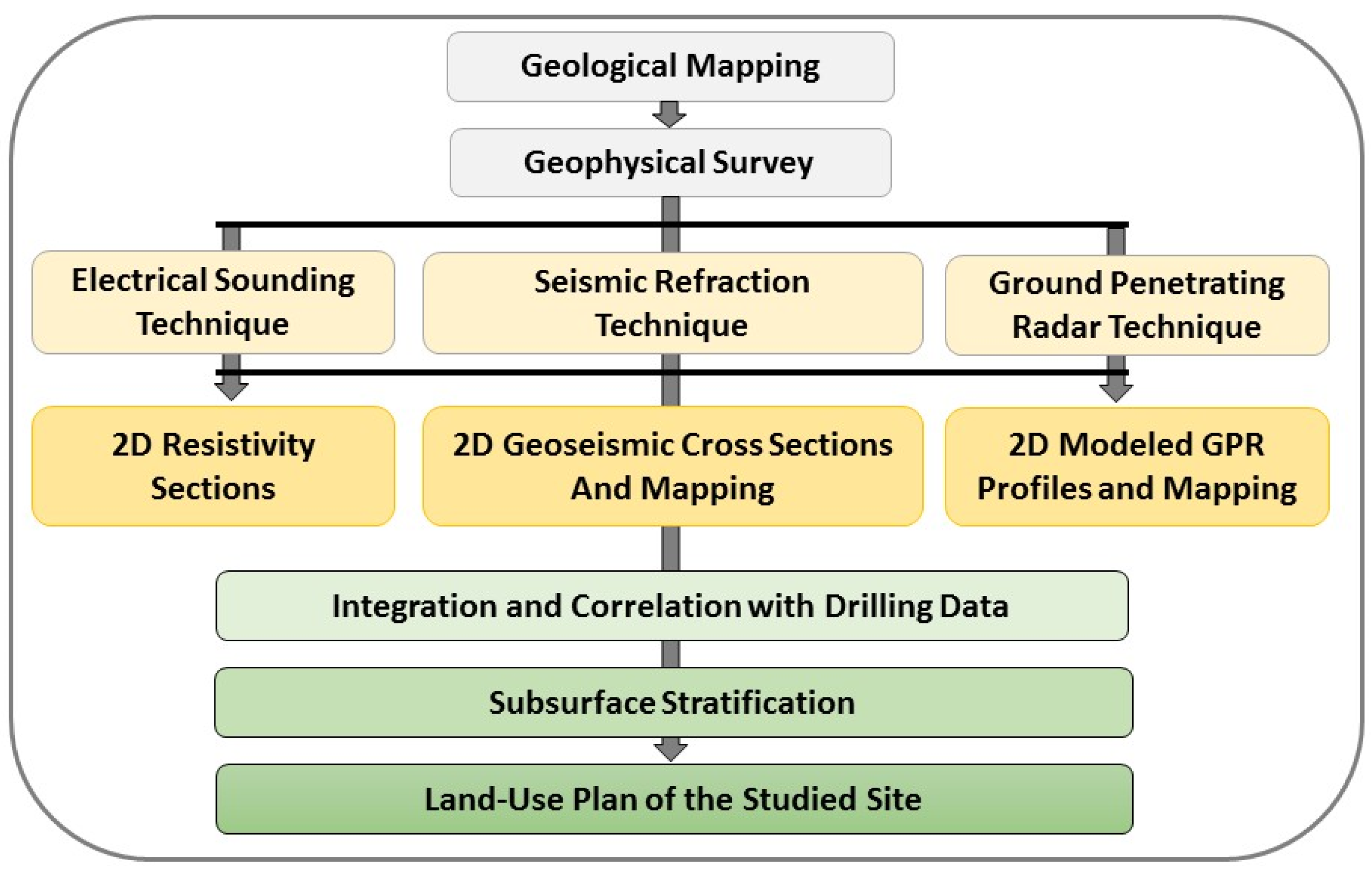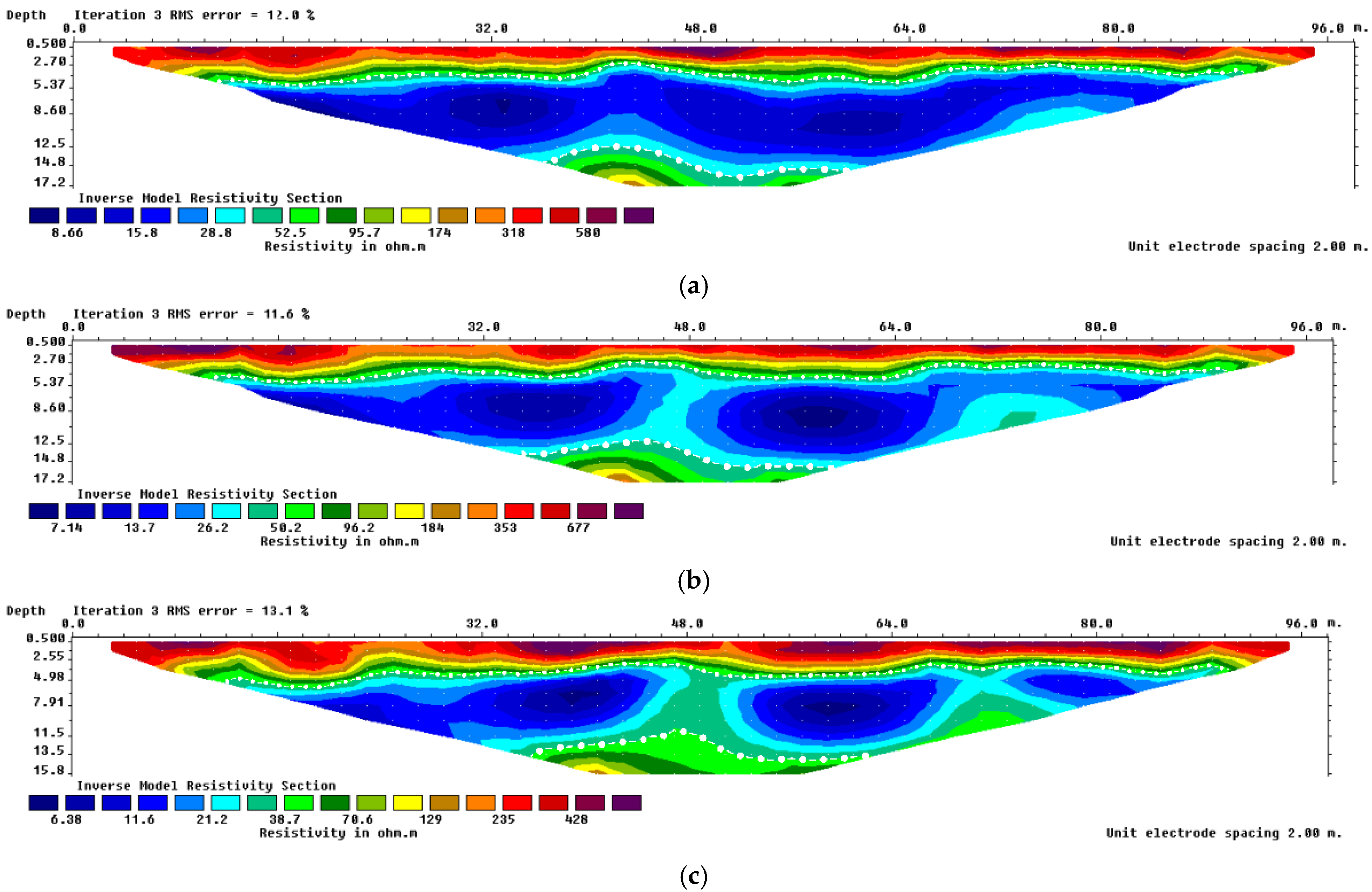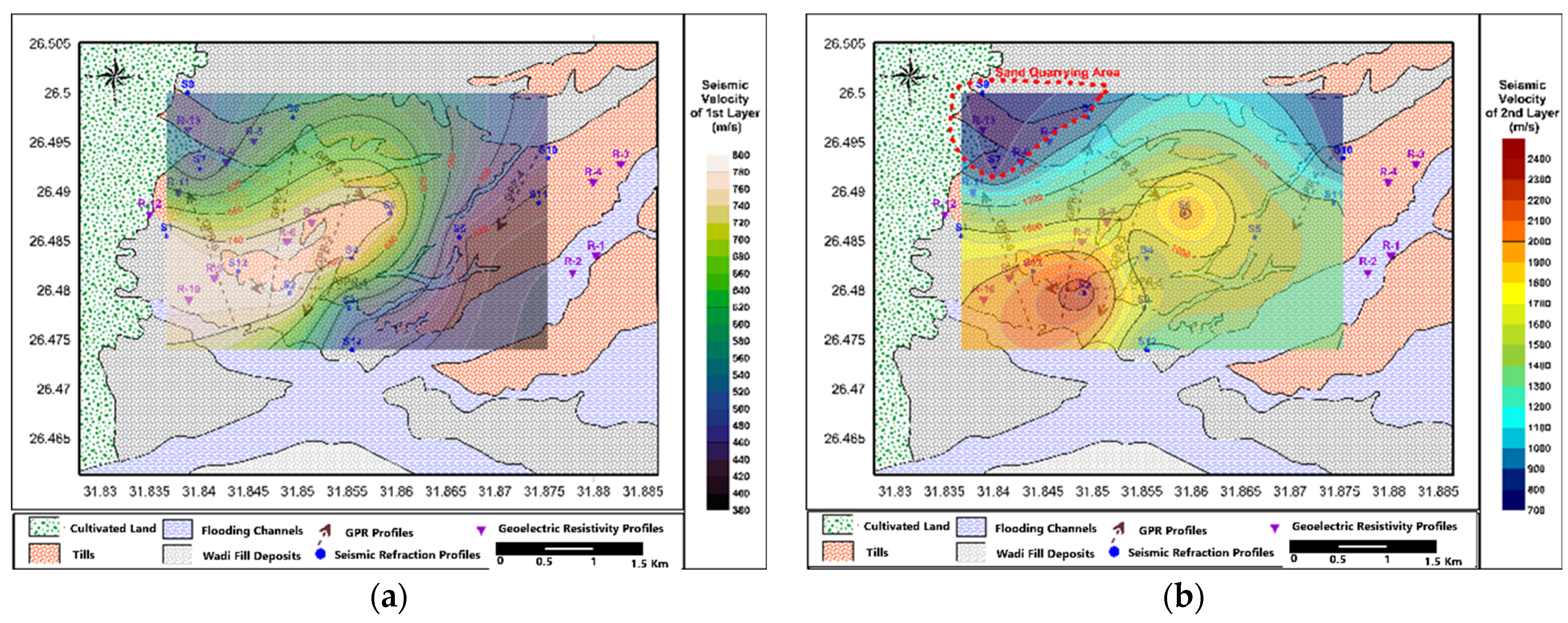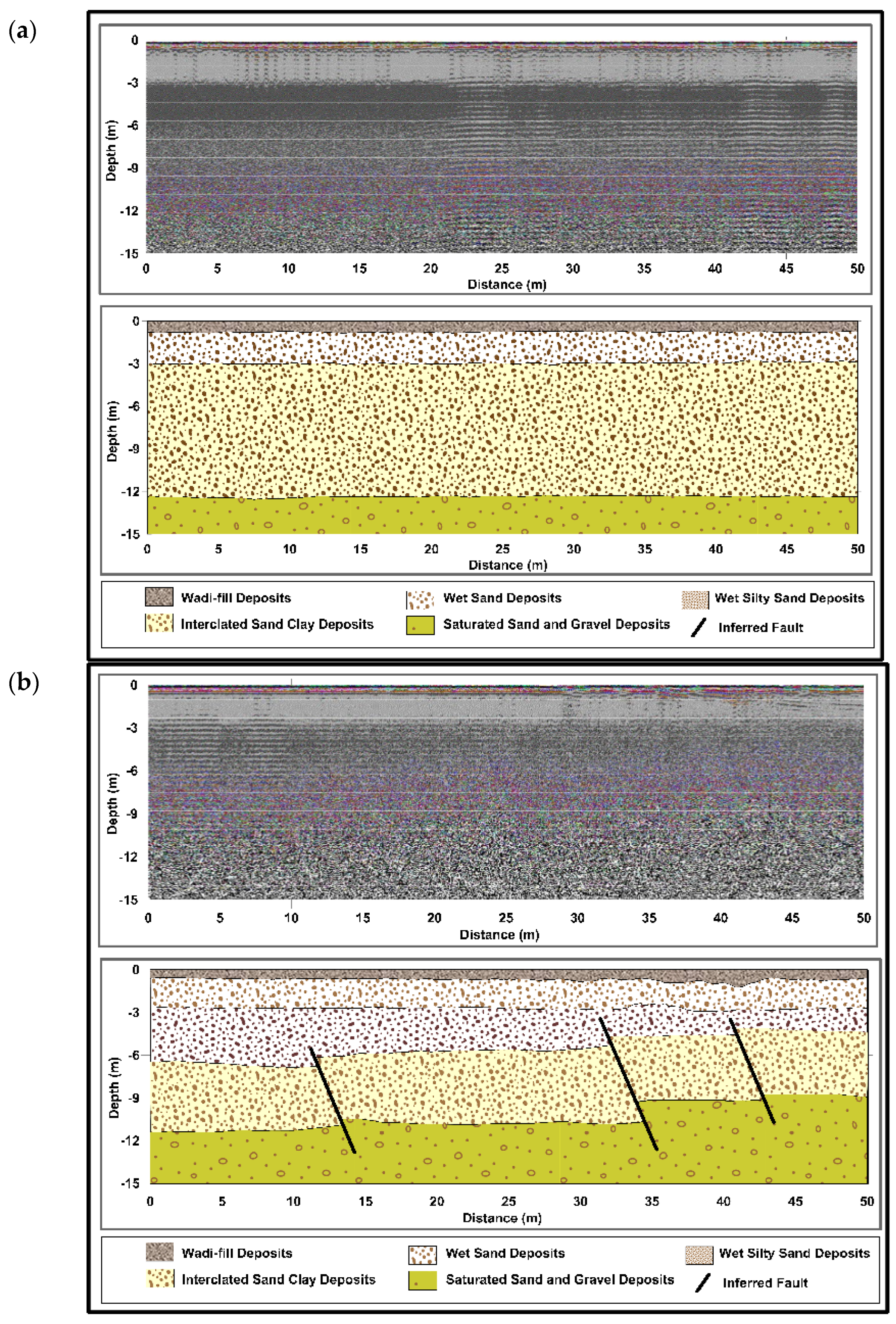Sustainable Urban Planning Using Integrated Geophysical Techniques in New Sohag City, Egypt
Abstract
1. Introduction
2. Geological and Structural Setting
3. Materials and Methods
3.1. Electrical Resistivity Tomography
3.2. Seismic Refraction
3.3. Ground Penetrating Radar
4. Results
4.1. Electrical Resistivity Tomography
- The surface wadi-fill deposits exhibit high resistivity values in the range of 184–684 Ohm.m, as shown in Figure 6a–c, due to the variation of the flooding nature of the Nile River over the past millions of years. The average thickness is 4.1 m across all the conducted profiles, and the materials are classified as surface friable sands, dry mud, silty sands, and clayey sands, as correlated with the gathered geologic information. The wide range of resistivities reflects different meteorological, seasonal, and sedimentation conditions in the first exposed layer.
- The second geoelectric layer, with a low resistivity range of 7.1–28.8 Ohm.m and a thickness of 9.2 m, is represented by deposits of wet sand, as shown in Figure 6a–c.
- The bottom layer extends to the maximum penetrable depth of the conducted ERT sections (17.2 m) and is characterized by moderate resistivity values ranging from 58.1 to 175.0 Ohm.m, corresponding to highly saturated sand and gravel deposits, which represent the groundwater aquifer, as shown in Figure 6a–c.
4.2. Seismic Refraction
- Surface wadi-fill deposits of seismic velocity ranging from 445 to 778 m/s, with a varying thickness through the conducted profiles ranging from 1 to 8 m.
- A second layer of wet sand with equivalent seismic velocity ranging from 1406 to 1660 m/s, with laterally varied thickness starting from 9 m as a minimum and, in some cases, extending to the maximum penetrable seismic profile (10 m).
- A third layer, which is detected only at profile S-02 in the middle of the studied area, with a seismic velocity of 2345 m/s, is represented by a highly consolidated claystone layer.
4.3. Ground Penetrating Radar
5. Discussion
- Agricultural areas: located in the western part of the study area, close to the Nile River, which is considered a source of agricultural projects.
- Groundwater aquifer: as confirmed by ERT, SR, and GPR geophysical techniques, the depth of the groundwater aquifer is very shallow, ranging from 6.5 to 15 m.
- Clay deposits: as present in the central and northeast parts of the study area, which can be utilized for reclamation and natural fertilization of the proposed land for agricultural activities.
- Excluding the floods and torrential paths, located in the south of the study area, and using them as open and garden areas to serve as breathable areas for the proposed new urban community.
- Excluding the highly faulted area, as concluded by GPR techniques, in the middle of the study area.
- Engineering treatment of the old quarrying areas, as depicted by the seismic refraction survey, in the northwest of the study area.
6. Conclusions
Funding
Institutional Review Board Statement
Informed Consent Statement
Data Availability Statement
Conflicts of Interest
References
- Fahmi, W.; Sutton, K. Greater Cairo’s Housing Crisis: Contested Spaces from Inner City Areas to New Communities. J. Cities 2008, 25, 277–297. [Google Scholar] [CrossRef]
- AbdelMaksoud, K.M.; Al-Metwaly, W.M.; Ruban, D.A.; Yashalova, N.N. Geological Heritage Under Strong Urbanization Pressure: El-Mokattam and Abu Roash as examples from Cairo, Egypt. J. Afr. Earth Sci. 2018, 141, 86–93. [Google Scholar] [CrossRef]
- El Araby, M. Urban Growth and Environmental Degradation: The Case of Cairo, Egypt. J. Cities 2002, 19, 389–400. [Google Scholar] [CrossRef]
- FAO. Guidelines for Land Use Planning; FAO: Rome, Italy, 1993; Available online: https://www.fao.org/4/t0715e/t0715e00.htm (accessed on 20 January 2025).
- FAO. Land Resource Planning for Sustainable Land Management; Land and Water Division Working Paper; FAO: Rome, Italy, 2017. [Google Scholar]
- Osman, M. Population Situation Analysis; Cooperation between UNFPA, Bassera Center, and National Population Council. 2016. Available online: https://egypt.unfpa.org/en/publications/population-situation-analysis-egypt-2016-report (accessed on 20 January 2025).
- Aly, H.Y.; Hamed, A.F.; Mohammed, N.A. Depression Among the Elderly Population in Sohag Governorate. Saudi Med. J. 2018, 39, 185–190. [Google Scholar] [CrossRef]
- Ghazala, H.H.; Ibraheem, I.M.; Haggag, M.; Lamees, M. An Integrated Approach to Evaluate the Possibility of Urban Development Around Sohag Governorate, Egypt, Using Potential Field data. Arab. J. Geosci. 2018, 11, 194. [Google Scholar] [CrossRef]
- Bishnoi, L.; Basu, P.C. Siting of Nuclear Installations. Nucl. India 2005, 38, 8–10. [Google Scholar]
- Oyediran, A.; Falae, P.O. Integrated Geophysical and Geotechnical Methods for Pre-Foundation Investigations. J. Geol. Geophys. 2018, 8, 453. [Google Scholar] [CrossRef]
- Benjumea, B.; Gabàs, A.; Macau, A.; Figueras, S.; Bellmunt, F. Application of Geophysical Techniques to Support Geological Mapping Projects. Spec. Top. Near Surf. Geosci. 2016, 34, 35–40. [Google Scholar] [CrossRef]
- Whiteley, R.J.; Stewart, S.B. Engineering Geophysics in Australia: Urban Case Studies from Downunder. In Proceedings of the 21st EEGS Symposium on the Application of Geophysics to Engineering and Environmental Problems, Philadelphia, PA, USA, 6–10 April 2008. [Google Scholar] [CrossRef]
- Deiana, R.; Bonetto, J.; Mazzariol, A. Integrated Electrical Resistivity Tomography and Ground Penetrating Radar Measurements Applied to Tomb Detection. Surv. Geophys. 2018, 39, 1081–1105. [Google Scholar] [CrossRef]
- Drahor, M.G.; Berge, A.M.; Öztürk, C. Integrated Geophysical Surveys for the Subsurface Mapping of Buried Structures Under and Surrounding of the Agios Voukolos Church in İzmir, Turkey. J. Archaeol. Sci. 2011, 38, 2231e2242. [Google Scholar] [CrossRef]
- Lee, S.C.H.; Noh, K.A.M.; Zakariah, M.N.A. High-Resolution Electrical Resistivity Tomography and Seismic Refraction for Groundwater Exploration in Fracture Hard Rocks: A Case Study in Kanthan, Perak, Malaysia. J. Asian Earth Sci. 2021, 218, 104880. [Google Scholar] [CrossRef]
- El-Gamilli, M. Geological and Geophysical Studies on Wadi El-Assuity Area, Eastern Desert, Egypt. Master’s Thesis, Assuit University, El Fateh, Egypt, 1964. [Google Scholar]
- Youssef, M.I. Structural Pattern of Egypt and its Interpretation. AAPG Bull. 1968, 52, 601–614. [Google Scholar]
- Senosy, M.M. Verification of the Qena Assiut Sedimentary Basin by Gravity Data. Egypt. J. Geol. 1997, 41, 797–816. [Google Scholar]
- Mahmoud, F.A. Subsurface Geological Conditions, as Deduced from Gravity and Magnetic Data in the Area East of El-Balyana, Sohag, Egypt. Master’s Thesis, South Valley University, Qena, Egypt, 1999. [Google Scholar]
- El-Emam, A.E. Geophysical Study Around the Epicenter of Earthquake of 1 May 1999, Sohag, Western Desert, Egypt. Master’s Thesis, El-Mansoura University, Mansoura, Egypt, 2002. [Google Scholar]
- Badawy, A.; Abdel-Monem, S.M.; Sakr, K.; Ali, S.M. Seismicity and Kinematic Evolution of Middle Egypt, National Research Institute of Astron and Geophysics, Helwan, Cairo. Egypt. J. Geodyn. 2006, 42, 28–37. [Google Scholar] [CrossRef]
- Shahid, S. Impact of Climate Change on Irrigation Water Demand of Dry Season Boro Rice in Northwest Bangladesh. Clim. Chang. 2011, 105, 433–453. [Google Scholar] [CrossRef]
- Bishay, Y. Biostratigraphic Study of the Eocene in the Eastern Desert between Samalut and Assiut by the Large Foraminifera; S N Publisher: Delhi, India, 1961. [Google Scholar]
- Bishay, Y. Studies on the Large Foraminifera of the Eocene (The Nile Valley between Assiut and Cairo and SW Sinai). Ph.D. Thesis, Alexandria University, Bab Sharqi, Egypt, 1966. [Google Scholar]
- El Naggar, Z. On a Proposed Lithostratigraphic Stratigraphic Subdivision for the Late Cretaceous-Early Paleogene Succession in the Nile Valley Egypt. In Proceedings of the 7th Arab Petroleum Congress Kuwait, Kuwait City, Kuwait, 16–22 March 1970. [Google Scholar]
- Attia, A. Parameter and Characteristics of the Groundwater Reservoir in Upper Egypt. Master’s Thesis, Faculty of Engineering, Cairo University, Al Giza, Egypt, 1974. [Google Scholar]
- Farrag, A.A. Hydrogeological Studies on the Quaternary Water-Bearing Sediments in the Area Between Assiut and Aswan. Master’s Thesis, Faculty of Science, Assiut University, El Fateh, Egypt, 1982. [Google Scholar]
- Omer, A. Geological, Mineralogical and Geochemical Studies on the Neogene and Quaternary Nile Basin Deposits, Qena-Assiut Stretch, Egypt. Ph.D. Thesis, Geology Department, Faculty of Science, South Valley University, Sohag, Egypt, 1996. [Google Scholar]
- Sheleby, A.; Said, M.; Eid, M. Paleogene Lithostatigraphy of the Area West of the Nile Valley between Qena and South Assiut. Annu. Geol. Surv. Egypt 2000, 23, 563–578. [Google Scholar]
- Omran, A.A.; Korany, E.A.; Abdel-Rahman, A.A. An Integrated Approach to Evaluate Groundwater Potentiality—A Case Study. In Proceedings of the 3rd International Conference of Applied Geophysical, Gniew, Poland, 21–23 June 2017. [Google Scholar]
- RIGW. Hydrogeological map of Egypt, 1st ed.; Scale 1:2000,000; Research Institute for Groundwater, Ministry of Public Works and Water Resources: Cairo, Egypt, 1989. [Google Scholar]
- Ismail, E.A.O. Environmental Investigations in the West Tahta Region, Upper Egypt: A Hydrogeochemical, Geophysical and Remote Sensing Study; Montanuniversität Leoben: Leoben, Austria, 2013. [Google Scholar]
- Fkirin, M.A.; Badawy, S.; El deery, M.F. Seismic Refraction Method to Study Subsoil Structure. J. Geol. Geophys. 2016, 5. [Google Scholar] [CrossRef]
- Davis, J.L.; Annan, A.P. Ground Penetrating Radar for High Resolution Mapping of Soil and Rock Stratigraphy. Geophys. Prospect. 1989, 37, 531–551. [Google Scholar] [CrossRef]
- Loke, M.H. Geoelectrical Imaging 2D & 3D, Rapid 2-D Resistivity & IP Inversion Using the Least-Squares Method; Geometrics Inc.: San Jose, CA, USA, 1999. [Google Scholar]
- Hagedoorn, J.G. The Plus-Minus Method of Interpreting Seismic Refraction Sections. Geophysical Prospecting. Geophys. Prospect. 1959, 7, 158–182. [Google Scholar] [CrossRef]
- Van Overmeeren, R.A. Hagedoorn’s plus-minus method: The beauty of simplicity. Geophys. Prospect. 2001, 49, 687–696. [Google Scholar] [CrossRef]
- Mitchum, R.M., Jr.; Vail, P.R.; Sangree, J.B. Seismic Stratigraphy and Global Changes of Sea Levels: Part 6. Stratigraphic Interpretation of Seismic Reflection Patterns in Depositional Sequences. In Seismic Stratigraphy–Applications to Hydrocarbon Exploration: AAPG Memoir; Payton, C.E., Ed.; AAPG: Tulsa, OK, USA, 1977; Volume 26, pp. 117–133. [Google Scholar]
- El Bastawesy, M.; Faid, A.; El Gammal, E.S. The Quaternary development of tributary channels to the Nile River at Kom Ombo area, Eastern Desert of Egypt, and their implication for groundwater resources. Hydrol. Process. 2010, 24, 1856–1865. [Google Scholar] [CrossRef]
- Abdelshafy, M.; Saber, M.; Abdelhaleem, A.; Abdelrazek, S.M.; Seleem, M. Hydrogeochemical Processes and Evaluation of Groundwater Aquifer at Sohag city, Egypt. Sci. Afr. 2019, 6, e00196. [Google Scholar] [CrossRef]
- De Wet, A.R.; Sternberg, R.; Winick, J. Interpreting Land-Use History by Integrating Aerial Photographs, Near-Surface Geophysics, and Field Observations Into a Digital Database. Environ. Eng. Geosci. 1999, V, 235–254. [Google Scholar] [CrossRef]
- Odgaard, M.V.; Dalgaard, T.; Bøcher, P.K.; Svenning, J. Site-specific modulators control how geophysical and socio-technical drivers shape land use and land cover. Geo Geogr. Environ. 2018, 5. [Google Scholar] [CrossRef]
- Molinari, C.; Menozzi, B.I.; Montanari, C.; Branch, N.; Stagno, A.M. Multidisciplinary approach for reconstructing past local land-use practices: Two case studies from the Ligurian Apennines, north-western Italy. Holocene 2025. [Google Scholar] [CrossRef]
- Liu, L.; Chan, L.S. Sustainable urban development and geophysics. J. Geophys. Eng. 2007, 4, 243. [Google Scholar] [CrossRef]
- Darul, A.; Irawan, D.E.; Agustine, E. Geophysics for the environment in Indonesia. F1000Research 2024, 13, 131. [Google Scholar] [CrossRef]
- Lapenna, V. Resilient and Sustainable Cities of Tomorrow: The Role of Applied Geophysics. Boll. Geofis. Teor. Appl. 2017, 58, 237–251. [Google Scholar] [CrossRef]
- Rana, S.; Mishra, V.N.; Rai, P.K. Applications of Geophysics in Structural and Geotechnical Engineering. In Best Practices in Geotechnical and Pavement Engineering; Kolathayar, S., Vinod Chandra Menon, N., Sreekeshava, K.S., Eds.; Lecture Note in Civil Engineering; Springer: Singapore, 2023; p. 449. [Google Scholar] [CrossRef]
- Locurcio, M.; Tajani, F.; Anelli, D. Sustainable Urban Planning Models for New Smart Cities and Effective Management of Land Take Dynamics. Land 2023, 12, 621. [Google Scholar] [CrossRef]
- Moreira, F.G.P.; Silva, L.E.C.; dos Santos, V.I.M. The Hidden Facets: Uncovering the Influence of Region on Social Housing Unit Distribution in Brazil. Buildings 2023, 13, 2208. [Google Scholar] [CrossRef]
- Omran, A.A. Integration of Remote Sensing, Geophysics and GIS to Evaluate Groundwater Potentiality—A Case Study in Sohag Region, Egypt. In Proceedings of the 3rd International Conference on Water Resources and Arid Environments (2008) and the 1st Arab Water Forum, Riyadh, Saudi Arabia, 16–19 November 2008. [Google Scholar]











Disclaimer/Publisher’s Note: The statements, opinions and data contained in all publications are solely those of the individual author(s) and contributor(s) and not of MDPI and/or the editor(s). MDPI and/or the editor(s) disclaim responsibility for any injury to people or property resulting from any ideas, methods, instructions or products referred to in the content. |
© 2025 by the author. Licensee MDPI, Basel, Switzerland. This article is an open access article distributed under the terms and conditions of the Creative Commons Attribution (CC BY) license (https://creativecommons.org/licenses/by/4.0/).
Share and Cite
Morsy, E.A. Sustainable Urban Planning Using Integrated Geophysical Techniques in New Sohag City, Egypt. Sustainability 2025, 17, 3730. https://doi.org/10.3390/su17083730
Morsy EA. Sustainable Urban Planning Using Integrated Geophysical Techniques in New Sohag City, Egypt. Sustainability. 2025; 17(8):3730. https://doi.org/10.3390/su17083730
Chicago/Turabian StyleMorsy, Essam A. 2025. "Sustainable Urban Planning Using Integrated Geophysical Techniques in New Sohag City, Egypt" Sustainability 17, no. 8: 3730. https://doi.org/10.3390/su17083730
APA StyleMorsy, E. A. (2025). Sustainable Urban Planning Using Integrated Geophysical Techniques in New Sohag City, Egypt. Sustainability, 17(8), 3730. https://doi.org/10.3390/su17083730





